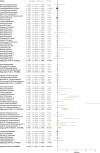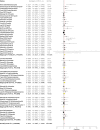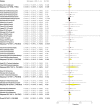Incidence of Adverse Events in Adults Undergoing Procedural Sedation in the Emergency Department: A Systematic Review and Meta-analysis
- PMID: 26801209
- PMCID: PMC4755157
- DOI: 10.1111/acem.12875
Incidence of Adverse Events in Adults Undergoing Procedural Sedation in the Emergency Department: A Systematic Review and Meta-analysis
Abstract
Objectives: This was a systematic review and meta-analysis to evaluate the incidence of adverse events in adults undergoing procedural sedation in the emergency department (ED).
Methods: Eight electronic databases were searched, including MEDLINE, EMBASE, EBSCO, CINAHL, CENTRAL, Cochrane Database of Systematic Reviews, Web of Science, and Scopus, from January 2005 through 2015. Randomized controlled trials and observational studies of adults undergoing procedural sedation in the ED that reported a priori selected outcomes and adverse events were included. Meta-analysis was performed using a random-effects model and reported as incidence rates with 95% confidence intervals (CIs).
Results: The search yielded 2,046 titles for review. Fifty-five articles were eligible, including 9,652 procedural sedations. The most common adverse event was hypoxia, with an incidence of 40.2 per 1,000 sedations (95% CI = 32.5 to 47.9), followed by vomiting with 16.4 per 1,000 sedations (95% CI = 9.7 to 23.0) and hypotension with 15.2 per 1,000 sedations (95% CI = 10.7 to 19.7). Severe adverse events requiring emergent medical intervention were rare, with one case of aspiration in 2,370 sedations (1.2 per 1,000), one case of laryngospasm in 883 sedations (4.2 per 1,000), and two intubations in 3,636 sedations (1.6 per 1,000). The incidence of agitation and vomiting were higher with ketamine (164.1 per 1,000 and 170.0 per 1,000, respectively). Apnea was more frequent with midazolam (51.4 per 1,000), and hypoxia was less frequent in patients who received ketamine/propofol compared to other combinations. The case of laryngospasm was in a patient who received ketamine, and the aspiration and intubations were in patients who received propofol. When propofol and ketamine are combined, the incidences of agitation, apnea, hypoxia, bradycardia, hypotension, and vomiting were lower compared to each medication separately.
Conclusions: Serious adverse events during procedural sedation like laryngospasm, aspiration, and intubation are exceedingly rare. Quantitative risk estimates are provided to facilitate shared decision-making, risk communication, and informed consent.
© 2016 The Authors. Academic Emergency Medicine published by Wiley Periodicals, Inc. on behalf of Society for Academic Emergency Medicine.
Figures







References
-
- Godwin SA, Burton JH, Gerardo CJ, et al. Clinical policy: procedural sedation and analgesia in the emergency department. Ann Emerg Med 2014;63:247–58. - PubMed
-
- Burton JH, Miner JR, Shipley ER, Strout TD, Becker C, Thode HC Jr. Propofol for emergency department procedural sedation and analgesia: a tale of three centers. Acad Emerg Med 2006;13:24–30. - PubMed
-
- Harvey M, Cave G, Betham C. Contemporary sedation practice in a large New Zealand emergency department. N Z Med J 2011;124:36–45. - PubMed
-
- Sacchetti A, Senula G, Strickland J, Dubin R. Procedural sedation in the community emergency department: initial results of the ProSCED registry. Acad Emerg Med 2007;14:41–6. - PubMed
-
- Taylor DM, Bell A, Holdgate A, et al. Risk factors for sedation‐related events during procedural sedation in the emergency department. Emerg Med Australas 2011;23:466–73. - PubMed
Publication types
MeSH terms
LinkOut - more resources
Full Text Sources
Other Literature Sources
Medical

